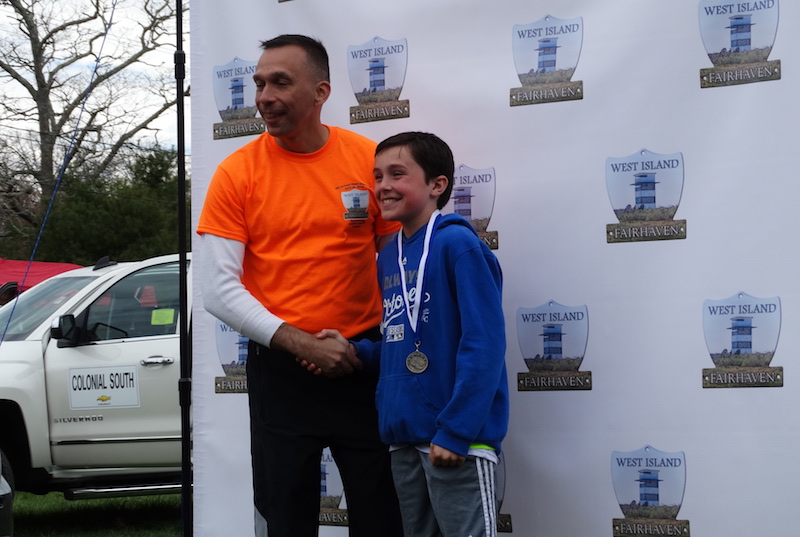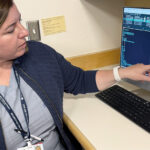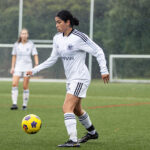Avulsion fracture taps the brakes on a runner’s races

By the time Will Benoit and his parents met Dr. Kristin Whitney, they all had a bad feeling about his left hip. “When she told us Will had a pelvic avulsion fracture, we knew his running season was over,” says his father, Russ. The question was, when would Will run again?
From third grade on, running has been Will’s outlet for fun, friends, and self-motivation. He ran his first half-marathon when he was 11 in 1 hour, 50 minutes. When he entered high school, the cross-country team provided another breakthrough opportunity. By sophomore year, he was surprising even himself with podium finishes. In 2018, a local paper, The Standard Times, named Will their Cross Country Runner of the Year (Boys).

Troubled by hip pain
Any runner knows the pain of burning muscles and fiery lungs. But early in his junior year, Will felt a new kind of pain in his left hip. He continued to train, hoping the pain would go away. Instead, at a local meet in October, his hip became too painful to ignore. “I really pushed myself during that meet,” says Will. “I had a fast time. But afterwards, I was in pain just walking.” The conference championships, the statewide meet he’d been preparing for all season, was two weeks away.
That evening, Will told his parents, Russ and Brigette. All three had a sinking feeling about what the pain could mean. For his part, Will knew how his muscles typically felt after a hard run — this felt different. For Russ, a physical therapist with a practice in Marion, Massachusetts, the fact that the pain was only on one side gave him pause. “I wouldn’t have been as worried if the soreness was on both sides.” Not only that, Will could point to the exact spot where the pain was coming from. “He was pointing at bone,” says Brigette.
Russ suggested a period of rest, which helped Will’s hip feel better. But anytime he ran, the pain flared again.
Diagnosis: Avulsion fracture
Will’s pediatrician took an x-ray of his hip and told the family that everything appeared normal. As much as they wanted to believe these results, they knew something serious was going on, so the pediatrician referred the family to Boston Children’s at North Dartmouth, just a few miles from the Benoit’s home in the South Coast region. There, they met Dr. Whitney, a running-medicine specialist with the Sports Medicine Division and its Injured Runner Clinic.

Looking at the x-ray, Dr. Whitney noticed an abnormality around the left iliac crest, the top of the hip bone. Next, she performed a bedside musculoskeletal sports ultrasound. Ultrasound images can provide detail that help clinicians evaluate growth plate, muscle, and tendon injuries. In this case, the ultrasound images confirmed that Will had a pelvic iliac crest avulsion fracture.
Avulsion fractures are a type of overuse injury that affect many young athletes. Growing kids have growth plates, sections of soft tissue, at both ends the long bones in their legs and arms. As an adolescent reaches their full height, the growth plates harden into solid bone. Until then, however, extreme or repeated physical exertion can cause a piece of the growth plate to separate from the rest of the bone. With continued stress, through cross country training, for instance, one of the tendons that connect muscle to bone can pull a piece of the growth plate away from the larger bone.
Injury confirmed. What now?
Though they finally knew why Will was in pain, the diagnosis confirmed the Benoits’ fear that he would have to take time off from running. If he didn’t, the injury would get worse. “Dr. Whitney convinced me that the smartest thing I could do was to miss out on the conference championship so I could compete in other meets in the future.”
Will had the last appointment of the day and Dr. Whitney, who is also a runner, spent extra time talking with the Benoits about the path forward. “It was so helpful to hear what we’d have to do to help Will heal,” says Russ. “She assured us that if he did the work, Will would be able to run again in time for the winter track season.” By the time they left the exam room, the sports medicine clinic had emptied out for the evening and Will had a plan.
Recovering from avulsion fracture through patience and hard work
Will describes his recovery as a team effort. “Dr. Whitney told us what we had to do, my dad did the PT, and I focused on getting better.” Every day after school, Will went to his father’s office for an hour of light exercises. Both father and son knew from Dr. Whitney which muscles needed to be stretched and which needed to be strengthened. They used cross-training strategies to maintain Will’s cardiovascular fitness while allowing his body time to heal.
After six weeks, Will got the go-ahead to run in small doses. At first, he would run for five minutes a day, paying close attention to whether the activity triggered any pain. After several more weeks of slow buildup, Dr. Whitney told him he could give racing a shot. Again, he had to promise to stop if he felt any pang of pain.

Will’s return to running
In mid-December, Will ran a 1-mile scrimmage with Dr. Whitney’s blessing. He finished the mile in 5 minutes, 3 seconds. “I did alright,” says the humble track star. In February, he competed in his first state meet since sophomore year. The night before the meet, after a pasta dinner with his parents, Will envisioned himself on the course, closing in on the finish line. “I’m so happy to be running again,” says Will. “I missed the feeling of running.”
Related
A gymnast gets her spring back
Learn more about our clinical services in North Dartmouth, Injured Runner Clinic, and Sports Medicine Division.
Related Posts :
-

Ask a sports medicine specialist: Why are ACL tears so common among female athletes?
When an athlete is sprinting after an opponent who suddenly stops or changes direction, their anterior cruciate ligaments (ACLs) make ...
-

Forging a path back to school after orthopedic trauma
Orthopedic trauma can force children to miss school, sometimes for an extended period. But even when patients have regained enough ...
-

Jackie’s dreams of playing professional soccer back on track after ACL surgery
From her dorm in Newcastle, England, Jackie Zapata can hear fans roaring in the soccer stadium a few blocks away. ...
-

What orthopedic trauma surgeons wish more parents knew about lawnmower injuries
Summer is full of delights: lemonade, ice cream, and fresh-cut grass to name a few. Unfortunately, the warmer months can ...





